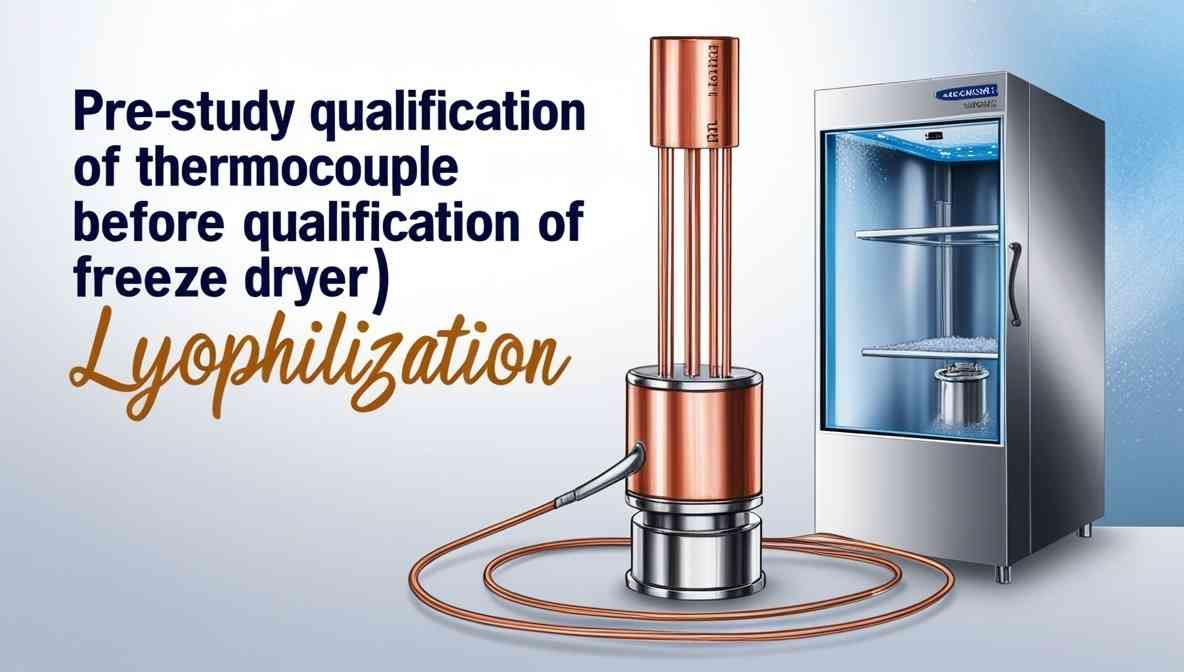Pre-study qualification of thermocouple before qualification of freeze dryer (Lyophilization) The pre-study qualification of thermocouples is a critical step in ensuring the reliability and accuracy of temperature measurements in freeze-drying and other temperature-sensitive processes. Proper calibration guarantees that thermocouples provide consistent and precise data, enabling optimal performance during qualification studies. This article outlines the objective, equipment, procedure, and acceptance criteria for thermocouple calibration, serving as a comprehensive guide for achieving robust results.
Description
Objective
The primary objective of this test is to calibrate thermocouples before use, ensuring they meet the required accuracy for qualification studies.
Test procedure
Required equipment/utensils
To conduct this procedure, the following equipment and utensils are essential:
- Kaye Validator/AVS
- Type of Thermocouple
- Temperature Bath (High/Low)
- Intelligent RTD
Qualification of Thermocouples in Temperature Baths.
Check & verify the calibration status of the Kaye system before starting calibration. Plug the thermocouples into the Kaye Validator/AVS. Program Kaye Validator/AVS as per the following parameters. :
- Calibration Set Point: Low: -60.0°C/*50.0°C, High: 140.0°C, Check: 121.1C
- Stability Criteria: Sensor Stability: 0.20°C for 3 minutes IRTD Stability: 0.025°C for 2 minutes/*0.012°C for 2 minutes
- Deviation Criteria: Uncalibrated Sensor: 1.00°C
- Calibrated Sensor: 0.50°C
- Log Corrected Results: 3, minutes
Place all the thermocouples and Intelligent RTD in the temperature bath. Attach the temperature bath and Intelligent RTD with the Kaye Validator/AVS and start the calibration as per standard operating procedure, respectively.
After completion of the calibration, attach the printout with the qualification report and record the maximum and minimum difference between the thermocouple and the Intelligent RTD. Do not use the thermocouple in the qualification study that varies more than +/-0.5 °C from the Intelligent RTD.
Note: Before starting up any activity of qualification, prepare the setup report of Kaye Validator/AVS, check it, and after that, load the setup in the validator.
Note*: Select Low Set Point at 50.0°C if the thermocouple is not going to be used for the 1 temperature mapping study; otherwise, select Low Set Point at -60.0°C if the thermocouple is being used for the temperature mapping study. Also select IRTD Stability at 0.025°C for 2 minutes when low set point selected at -60.0°C and at 0.012°C for 2 minutes when low set point selected at 50°C.
Acceptance criteria: No thermocouple should vary by more than +/- 0.5 °C from the Intelligent RTD temperature.
Conclusion
The pre-study qualification of thermocouples is a vital process to ensure measurement accuracy in temperature mapping and validation studies. By adhering to stringent calibration procedures and acceptance criteria, organizations can guarantee precise results, reducing the risk of errors in critical freeze-drying processes.
Summary
Proper calibration of thermocouples before use ensures accurate temperature measurement, a cornerstone for successful qualification studies. This guide outlines the essential equipment, step-by-step procedure, and acceptance criteria to achieve reliable calibration outcomes, supporting freeze-drying operations with precision and consistency.
FAQs
1. Why is thermocouple calibration necessary before qualification studies?
Calibration ensures that thermocouples provide precise temperature measurements, critical for achieving reliable results in qualification studies.
2. What equipment is required for thermocouple qualification?
Essential tools include the Kaye Validator, temperature bath, thermocouples, and Intelligent RTD.
3. What are the acceptance criteria for calibrated thermocouples?
Thermocouples should not deviate by more than ±0.5°C from the Intelligent RTD.
4. How should I select the low calibration set point?
Select -60.0°C for temperature mapping studies and 50.0°C for non-temperature mapping studies.
5. Can uncalibrated thermocouples be used in qualification studies?
No, uncalibrated thermocouples may lead to inaccurate results, jeopardizing the reliability of the study.
Internal Links
For more insights on freeze-drying processes, explore the following resources:
